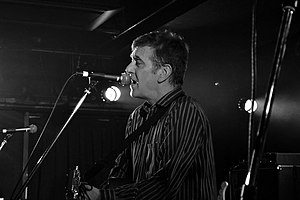Tommy Keene (born Thomas Clay Keene; June 30, 1958 – November 22, 2017)[1] was an American singer-songwriter, best known for releasing critically acclaimed rock & roll/power pop songs in the 1980s. He has a longtime cult following among fans of the musical genre of power pop.[2]
Tommy Keene | |
|---|---|
 | |
| Background information | |
| Birth name | Thomas Clay Keene |
| Born | June 30, 1958 Evanston, Illinois, United States |
| Origin | Bethesda, Maryland, United States |
| Died | November 22, 2017 (aged 59) |
| Genres | Power pop, jangle pop, rock & roll, pop rock, indie rock, alternative rock |
| Occupation(s) | Singer, songwriter |
| Instrument(s) | Guitar, vocals |
| Years active | 1979–2017 |
| Labels | Avenue, Dolphin, Geffen, Matador, Alias, Parasol, spinART, Not Lame, Eleven Thirty, Second Motion |
| Formerly of | Robert Pollard, Paul Westerberg, Goo Goo Dolls, Velvet Crush, (The) Razz, Richard X. Heyman |
| Website | www |
Education
editEvanston, Illinois-born Keene was raised in Bethesda, Maryland. He graduated in 1976 from Walter Johnson High School in Bethesda, which was also the alma mater of fellow musician Nils Lofgren, who went on to play and record with Neil Young and Bruce Springsteen. Keene played drums in one version of Lofgren's early bands.[3] Keene then attended the University of Maryland, College Park.[4]
Musical career
editKeene first received critical acclaim with the pioneering Washington, D.C. rock band The Razz, who released several local independent singles. His 1984 EP Places That Are Gone became one of the year's top selling independent releases.[5] That same year, Washington City Paper dubbed Keene "one of the best pop songwriters anywhere."[6] Places That Are Gone garnered a four-star review in Rolling Stone, and was voted the No. 1 EP in the following year's Village Voice Pazz & Jop Poll. Keene recorded and released numerous albums on such labels as Dolphin, Geffen and Matador Records. He worked with producers T-Bone Burnett, Don Dixon, and R. Walt Vincent. He continued to record and tour and released an album with Robert Pollard, of Guided by Voices, as 'The Keene Brothers.' He was also a member of Pollard's live backing band "The Ascended Masters" also featuring Jon Wurster, Jason Narducy, and Dave Phillips. As well, he toured as an additional guitar player in Pollard's Boston Spaceships. Keene also played guitar on the Goo Goo Dolls' hit song, "Broadway", on their 1998 album, Dizzy Up The Girl.[7]
In 2011, Keene released his ninth original studio album, Behind The Parade on Second Motion Records. This was the fourth release working with Second Motion's founder Stephen Judge. Judge had released Keene's 2010 two-disc retrospective Tommy Keene: You Hear Me and his previous release, Crashing The Ether. Keene's 2006 release Eleven Thirty Records was released while Judge was A&R Director and general manager at Redeye Distribution.
Death
editKeene died in his sleep on November 22, 2017, at the age of 59 due to cardiac arrest.[8]
Discography
editAlbums
edit- Strange Alliance (1982, Avenue)
- Songs from the Film (1986, Geffen) U.S. No. 148[9]
- Based on Happy Times (1989, Geffen)
- Ten Years After (1996, Matador)
- Isolation Party (1998, Matador)
- The Merry-Go-Round Broke Down (2002, spinART)
- Crashing the Ether (2006, Eleven Thirty)
- In the Late Bright (2009, Second Motion Records)
- Behind the Parade (2011, Second Motion Records)
- Excitement at Your Feet (2013, Second Motion Records)
- Laugh in the Dark (2015, Second Motion Records)
Compilation albums
edit- The Real Underground (1993, Alias)
- Driving into the Sun (1994, Alias)
- Drowning—A Tommy Keene Miscellany (2004, Not Lame)
- Tommy Keene You Hear Me: A Retrospective - 1983-2009 (2010, Second Motion Records)
Live albums
edit- Showtunes (2001, Parasol Records)
- Showtunes II (2016, Self Released)
EPs
edit- Places That Are Gone (1984, Dolphin)
- Back Again (Try...) (1984, Dolphin)
- Run Now (1986, Geffen)
- Sleeping on a Roller Coaster (1992, Matador)
References
edit- ^ Salam, Maya (November 24, 2017). "Tommy Keene, power-pop songwriter and star of '80s D.C. music scene, dies at 59". The Washington Post. Retrieved December 7, 2017.
- ^ "Tommy Keene". TrouserPress.com. Retrieved September 6, 2015.
- ^ "Cult Rocker Tommy Keene, R.I.P." That Devil Music. Retrieved January 6, 2019.
- ^ "In Our Lives". No Such Thing As Was. Retrieved January 6, 2019.
- ^ Jack Leaver. "Places That Are Gone – Tommy Keene | Songs, Reviews, Credits, Awards". AllMusic. Retrieved September 6, 2015.
- ^ "City Paper, October 19, 1984 | Dig DC". dcplislandora.wrlc.org. Retrieved July 25, 2021.
- ^ "Tommy Keene at CBGB (03-28-1990)". The Mckenzie Tapes. March 28, 2020. Archived from the original on September 26, 2021. Retrieved January 21, 2022.
- ^ "Tommy Keene 6/30/58 – 11/22/17 – Tommy Keene". Tommykeene.com. November 23, 2017.
- ^ "Top 200 Albums". Billboard. July 1, 1986. Retrieved September 6, 2015.
External links
edit- Official website
- Tommy Keene at AllMusic
- Tommy Keene discography at Discogs
- "It's Peachy for Keene: Musician's Musician Tommy Keene Releases a New CD of Irresistible Pop. and as a Bonus, He Comes Out" by Reighley, Kurt B. – The Advocate (The national gay & lesbian newsmagazine), May 9, 2006 Archived March 30, 2016, at the Wayback Machine